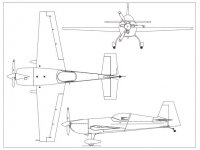You are using an out of date browser. It may not display this or other websites correctly.
You should upgrade or use an alternative browser.
You should upgrade or use an alternative browser.
Over-Thick Control Surfaces
- Thread starter Wacobipe
- Start date
Maxwell1945
50cc
I think if I remember right, That the Germans used thicker Elevators and Ailerons back it the 1930s on the Bucker Bi-planes.
Thanks Van
Thanks Van
WMcNabb
150cc
I've been drooling over Severin's Jungmeister kit lately.
Not sure if this is perfectly scale but....look how much of the aileron and elevator are ahead of their respective hinges.
http://www.paoloseverin.it/Bucker/Bucker Download/files/BuWings.jpg
http://www.paoloseverin.it/Bucker/Bucker Download/files/BuFuse.jpg
Not sure if this is perfectly scale but....look how much of the aileron and elevator are ahead of their respective hinges.
http://www.paoloseverin.it/Bucker/Bucker Download/files/BuWings.jpg
http://www.paoloseverin.it/Bucker/Bucker Download/files/BuFuse.jpg
Pistolera
HEY!..GET OUTTA MY TREE!
That design is referred to as Frise-type ailerons. A bit from Wikkipedia;
Frise ailerons
Engineer Leslie George Frise (1897–1979) of the Bristol Aeroplane Company developed an aileron shape that is pivoted at about its 25 to 30% chord line and near its bottom surface [1], in order to decrease stick forces as aircraft became faster during the 1930s. When the aileron is deflected up (to make its wing go down), the leading edge of the aileron dips into the airflow beneath the wing. The moment of the leading edge in the airflow helps to move up the trailing edge, which decreases the stick force. The down-moving aileron also adds energy to the boundary layer. The edge of the aileron directs air flow from the under-side of the wing to the upper surface of the aileron, thus creating a lifting force, which adds to the lift of the wing. This reduces the needed deflection angle of the aileron. The popular American Piper J-3 Cub light aircraft of 1938 possessed Frise ailerons as designed, and helped introduce them to a wide audience.
The Frise aileron bonus is often described as its ability to counteract adverse yaw. To do so, the leading edge of the aileron has to be sharp or bluntly rounded, that adds significant drag to the going up aileron and helps the aircraft to yaw (turn) in the desired direction, but adds some unpleasant, non linear effect and or potentially dangerous aerodynamic vibration (flutter). In fact the use of differential aileron movements — as with the famous de Havilland Tiger Moth biplane — is much more efficient to decrease adverse yaw moments.
Frise ailerons
Engineer Leslie George Frise (1897–1979) of the Bristol Aeroplane Company developed an aileron shape that is pivoted at about its 25 to 30% chord line and near its bottom surface [1], in order to decrease stick forces as aircraft became faster during the 1930s. When the aileron is deflected up (to make its wing go down), the leading edge of the aileron dips into the airflow beneath the wing. The moment of the leading edge in the airflow helps to move up the trailing edge, which decreases the stick force. The down-moving aileron also adds energy to the boundary layer. The edge of the aileron directs air flow from the under-side of the wing to the upper surface of the aileron, thus creating a lifting force, which adds to the lift of the wing. This reduces the needed deflection angle of the aileron. The popular American Piper J-3 Cub light aircraft of 1938 possessed Frise ailerons as designed, and helped introduce them to a wide audience.
The Frise aileron bonus is often described as its ability to counteract adverse yaw. To do so, the leading edge of the aileron has to be sharp or bluntly rounded, that adds significant drag to the going up aileron and helps the aircraft to yaw (turn) in the desired direction, but adds some unpleasant, non linear effect and or potentially dangerous aerodynamic vibration (flutter). In fact the use of differential aileron movements — as with the famous de Havilland Tiger Moth biplane — is much more efficient to decrease adverse yaw moments.
Pistolera
HEY!..GET OUTTA MY TREE!
If it is noticeable, I would think it may be a bit more responsive. I don't think it would do anything regarding adverse yaw though. I think the recessed hinge, referred to as the "SS" style earlier in this thread would be more responsive than anything in a scale form. You can see this on the Sukhoi below. The left aileron is deflected up and you can see through the gap where the leading edge is beneath the wing. Conversely, the right one is down and you can clearly see the leading edge raised up above the wing.

Pistolera
HEY!..GET OUTTA MY TREE!
Yep...they're fairly common these days....I just didn't have any shots that showed it like the SU-31 above.
Oh....and other interesting thing that you can see on the 3-view you posted, is the reverse taper of the ailerons! They get larger in chord toward the tip....(not counting the aerodynamic balance at the tip) . Haven't seen any RC planes with this.....kinda wish Krill would've done it.
. Haven't seen any RC planes with this.....kinda wish Krill would've done it.
You can see it again in this shot of Mike's 330SC.

Oh....and other interesting thing that you can see on the 3-view you posted, is the reverse taper of the ailerons! They get larger in chord toward the tip....(not counting the aerodynamic balance at the tip)
You can see it again in this shot of Mike's 330SC.
Last edited:


